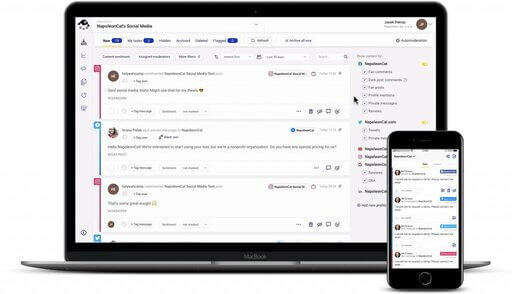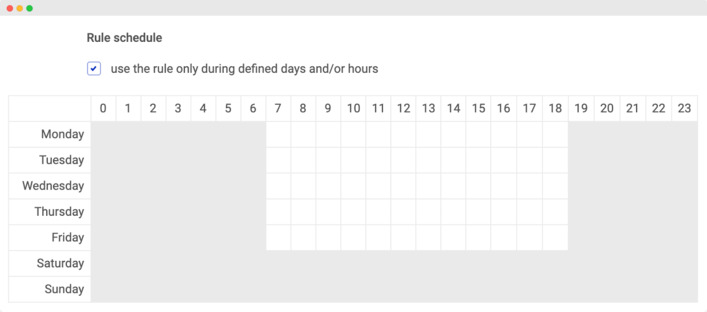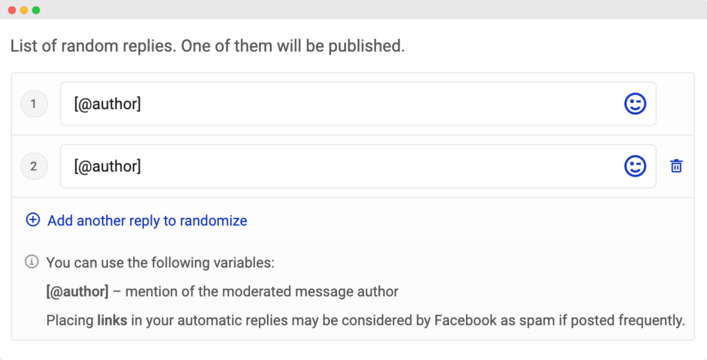There’s a whole list of challenges social media marketers face these days. One of the biggest ones? I think it’s the always-on mentality a lot of customers have. Luckily, they have tools that can effectively support them in tackling these challenges – and social media automation is a huge one.
In this article, I’ll show you that:
- keeping customers happy on social media is possible,
- you can do it effectively using automation,
- and it is pretty easy to configure it.

Automate Social Media Moderation, Publishing, and Reporting
Automate social media comment moderation (ad comments included), publishing, reporting & more – with an all-in-one social media tool.
Let’s face it – once you set up your Facebook page or Twitter account as a brand, the notion of “business hours” magically vanishes into thin air. Everyone expects you to be available anytime. Answer as fast as you can. People (some more than others) have become incredibly impatient. Nobody likes it when others keep them waiting.
And of course, you’ll want to make your customers happy – that’s your job if you’re going to build a successful brand. But you also can’t be stressing your team (or yourself) out indefinitely – they’ll quickly become unproductive, and the whole thing will yield opposite results.
You need technology to support them and make their lives easier – so they can make your customers’ lives easier, too.

Keeping customers happy on social – is that even possible?
Yeah, I heard you asking yourself that in your head (okay, I just imagined that. But I can only imagine that because I’ve been there myself.)
You can certainly make them UNhappy. By doing things like:
- ignoring their messages (or not noticing their messages, which boils down to the same thing – never replying)
- providing unhelpful, irrelevant responses (either because you don’t have the time or the team to support you, or because you’re just scrambling to keep up the response rate but at the expense of the quality of your responses)
- not communicating consistently in general – maybe that one won’t make them unhappy, but it might indeed make them ignorant of your brand’s existence. They’ll forget about you if you never show up.
Countless research studies prove it: customers who are satisfied with how you talk to them on social, are more likely to buy from you or spend significantly more on your products or services.
Research also shows customer experience is becoming more important than price and product as your key differentiator.
But how do you make them happy, especially when so many customers take to social media to ask questions or complain?
There’s one tool that can help a lot in this. Social media automation.
But let’s make something clear first. Because I know it’s on the mind of a lot of digital marketers.
There’s nothing wrong with automating your replies on social
Automation on social media has had some bad press. For some, the sole concept of automating social media responses is just appalling. Because “social media is a conversation” and how can you automate a conversation?

I don’t think it deserves the bad press it’s received from some. In marketing, in general, most of the tools and channels that get a bad reputation or are thought to “not work” are not used right.
Automated doesn’t mean “robotic”. On social, it can:
- help you quickly respond to a query before a team member has a chance to look into it (especially if it’s outside business hours)
- spend less time answering the same questions, leaving more time to solve complex problems
- consistently engage your audience, start valuable conversations and keep up with them
- ultimately, help you provide a better customer experience (not worse, as some like to think.)
But of course, you need to get it right. And, as with everything, automation needs humans – smart marketers who know how to use it, set it up, and keep an eye on it to adjust and intervene whenever necessary.

Manage all comments and messages from one view + automate your replies
Use NapoleonCat to manage all of your comments, messages, reviews, etc. – with an all-in-one social media tool. Automate replies to repetitive questions and automatically delete spammy comments.
Now how does it work, exactly?
Using Auto-moderation in NapoleonCat, you can solve a lot of the day-to-day communication that takes up your team’s time – both when it comes to initiation conversations and responding to them. Here’s a handful of ways you can use it:
Don’t leave questions unanswered
Automate responses to simple, repetitive questions to answer them quicker, without engaging your team.
- What hours are you open?
- What sizes/colors/models are available?
- How much is the shipping?
- What’s on today’s menu?
- and so on, and so forth.
To do that, set up rules using specified keywords. Decide what triggers the reply: private message, post to a page, ad comment, etc. Use your responses to direct your fans to helpful content, frequently asked questions, or video tutorials.
(Just be mindful of the fact that placing links in your automatic replies may be considered by Facebook as spam if posted too frequently.)
If you need to tackle sensitive information like order details, you can choose to reply in a private message regardless of where the original question came from.
And finally, automatically redirect issues to team members that can handle them best.
Get more time for quality conversations and solutions to more complex problems
Handling the questions and comments that are easiest to answer with automated replies leaves you with so much more time to tackle the more complex ones, that usually require more attention (and which can get lost in the deluge of all the notifications.)
If a customer has a technical issue with the product or delivery, has a legal consideration you need to check, or just a very unusual question that no script could’ve predicted, you get more time to look for a helpful answer.
So auto-moderation acts like a filter, leaving you with the most complex issues. And you (or someone on your team) have more time to dig in the hard stuff – and help customers better.
Let your customers know when they’ll hear back from you
Let’s face it, social media works 24/7 – and most companies don’t.
And that’s just life – people need to live outside work, and your team can’t be plugged into your social channels 24/7 (not in the long run, at least.)
But on the other hand, your customers – used to the fact they can communicate with brands freely – might expect answers even if they message you on a Friday night. That is why having a way to reply instantly is so convenient, even if it’s just letting them know when someone will be able to read their message and reply.
This way, you can communicate outside of your operating hours, without straining yourself or your team AND without ignoring your customers and leaving them without any kind of reply.
Win-win.
To do that, use the rule schedule while setting up your automated rules to only reply on certain days of the week (e.g., on weekends) and during defined hours.

Get ahead of a crisis
Automating social media communication is a great way to quickly react when something blows up on social.
(Especially outside of your operating hours, which is when it probably will happen.)
Whether your service is down or something’s not working the way it’s supposed to (and that you can predict may happen at some point), you gain precious time to act, while your customers are not left hanging (and getting more and more frustrated by the minute.)
If you’re afraid posting the same replies to everyone will look bad, you can create several replies, and the system will randomize them, so your fans will not see a string of the same replies (especially when there’s a lot of them.)

Sometimes it’s enough to let people know “you’re working on it” – so they can feel reassured, and you’re building trust – priceless for a brand.
Automate your posting schedule
Of course, social media communication is not just reacting to what’s coming your way.
If you want to consistently keep an engaged (and happy) community of followers and customers, you need to proactively engage them in conversations.
And here, automation plays a key role. Gone (I hope) are the days when Facebook moderators typed all their posts by hand and published them instantly, every day, sometimes several times a day. And imagine what happened if you catered to a global audience, with fans and followers located from the US West Coast all the way to Australia, with the marketing team somewhere in the middle, managing all the international communications.
Social media engagement (and your content visibility and reach, as a result) thrives on regular updates. And automating your publishing calendar is now a must-have to help you keep a consistent schedule. Combine that with automated replies and notifications, and you’re covering a good chunk of your social media operations.
And with NapoleonCat, you don’t need separate social media automation tools for that (which is sometimes the case.) Go to the publisher in your account to create and share a publishing schedule, create tasks and assign them to team members, and specify visibility settings for individual posts.

Protect your social media from SPAM
Automatically hide or delete comments containing spam under your organic posts and ads – with an all-in-one social media tool.
Things to remember when you write and schedule your automated posts and replies
Now, using the tool is one thing, but crafting your automated social media messages is another. Here are a few best practices that can make it easier – and much more effective.
1. Keep it human.
Even if you’re automating your replies, you’re not a robot. Use words you would otherwise use talking to a customer. If you have a consistent brand voice (which I hope you do!), use it on your automated replies.
Let your customers know that even if it’s an automated message, there’s a real human behind it.
2. Be honest and open.
Don’t hide the fact your replies are automated. Let me say that again – there’s nothing wrong with automating your replies. Your customers (or, most of them, eventually) WILL understand you’re currently unavailable. If you let them know.
Sometimes, letting your customers know explicitly a message is automated may be even better. They don’t get their hopes up, but appreciate knowing when they can expect a reply.
3. Don’t shy away from humor
(if appropriate for your brand and your audience.) This one is tricky, as you have to consider your customer’s state of mind at that current moment. So if they’re complaining, don’t fuel their frustration with jokes and emoji. But if there’s no risk of a message mismatch (e.g. they’re just asking about a price of something), don’t be afraid to be casual and funny from time to time.
4. Be helpful.
Before writing your automated reply, step into your customer’s shoes. Look to past messages, customer service logs, or online reviews to search for specific problems that appear the most, and use that knowledge to craft helpful replies and direct people to relevant sources like FAQs or blog posts.
5. Plan ahead.
It might not be the most original piece of advice, but I think it’s worth repeating every once in a while. Set aside some time on Monday (or Friday) to schedule posts for the entire week – and then focus on other stuff (like keeping up conversations and replying to people.)
6. Avoid rookie mistakes.
Read everything twice. Make sure there are no typos, or no leftover placeholder content or workable titles someone (often you) forgot to change before the post went live. If you’re waiting on images from your designer to add later on, set up reminders on your calendar, so you don’t forget to actually add them.
Don’t let them wait. Automate
Put automation to good use on your social media channels. It won’t replace human contact, but it can be an efficient and super helpful tool to maintain it and keep tabs on all that’s going on. And that’s a great starting point to consistently keeping your customers happy.
If you’d like to learn more about social media automation, we recommend the following articles:
- Best Instagram Automation Tools
- Top 11 Facebook Automation Tools
- The Easiest Way to Implement Facebook Automation
- How to Automate Social Media Marketing
- 6 Uses of Social Media Marketing Automation
- Marketing Automation Statistics You Should Know
- Your 2023 Guide to eCommerce Automation on Social Media
- How to Automate Your Social Media During Holidays




